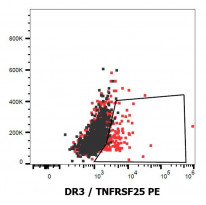ARG42453
anti-DR3 / TNFRSF25 antibody [JD3] (PE)
anti-DR3 / TNFRSF25 antibody [JD3] (PE) for Flow cytometry and Human
Overview
| Product Description | PE-conjugated Mouse Monoclonal antibody [JD3] recognizes DR3 / TNFRSF25 |
|---|---|
| Tested Reactivity | Hu |
| Tested Application | FACS |
| Specificity | The mouse monoclonal antibody JD3 recognizes an extracellular epitope of DR3 (APO-3, TNFRSF25), a transmembrane protein of TNFR superfamily expressed mainly in lymphocyte-enriched tissues. |
| Host | Mouse |
| Clonality | Monoclonal |
| Clone | JD3 |
| Isotype | IgG1 |
| Target Name | DR3 / TNFRSF25 |
| Antigen Species | Human |
| Immunogen | Human DR3-Ig fusion protein. |
| Conjugation | PE |
| Alternate Names | WSL-1; Apo-3; Apoptosis-mediating receptor TRAMP; DDR3; DR3; Protein WSL; Protein WSL-1; TRAMP; Apoptosis-inducing receptor AIR; TNFRSF12; Death receptor 3; LARD; Apoptosis-mediating receptor DR3; TR3; APO-3; Lymphocyte-associated receptor of death; Tumor necrosis factor receptor superfamily member 25; WSL-LR |
Application Instructions
| Application Suggestion |
|
||||
|---|---|---|---|---|---|
| Application Note | * The dilutions indicate recommended starting dilutions and the optimal dilutions or concentrations should be determined by the scientist. |
Properties
| Form | Liquid |
|---|---|
| Purification | Purified |
| Buffer | PBS and 15 mM Sodium azide. |
| Preservative | 15 mM Sodium azide |
| Storage Instruction | Aliquot and store in the dark at 2-8°C. Keep protected from prolonged exposure to light. Avoid repeated freeze/thaw cycles. Suggest spin the vial prior to opening. The antibody solution should be gently mixed before use. |
| Note | For laboratory research only, not for drug, diagnostic or other use. |
Bioinformation
| Database Links |
Swiss-port # Q93038 Human Tumor necrosis factor receptor superfamily member 25 |
|---|---|
| Gene Symbol | TNFRSF25 |
| Gene Full Name | tumor necrosis factor receptor superfamily, member 25 |
| Background | The protein encoded by this gene is a member of the TNF-receptor superfamily. This receptor is expressed preferentially in the tissues enriched in lymphocytes, and it may play a role in regulating lymphocyte homeostasis. This receptor has been shown to stimulate NF-kappa B activity and regulate cell apoptosis. The signal transduction of this receptor is mediated by various death domain containing adaptor proteins. Knockout studies in mice suggested the role of this gene in the removal of self-reactive T cells in the thymus. Multiple alternatively spliced transcript variants of this gene encoding distinct isoforms have been reported, most of which are potentially secreted molecules. The alternative splicing of this gene in B and T cells encounters a programmed change upon T-cell activation, which predominantly produces full-length, membrane bound isoforms, and is thought to be involved in controlling lymphocyte proliferation induced by T-cell activation. [provided by RefSeq, Jul 2008] |
| Function | Receptor for TNFSF12/APO3L/TWEAK. Interacts directly with the adapter TRADD. Mediates activation of NF-kappa-B and induces apoptosis. May play a role in regulating lymphocyte homeostasis. [UniProt] |
| Cellular Localization | Isoform 1: Cell membrane; Single-pass type I membrane protein. Isoform 2: Cell membrane; Single-pass type I membrane protein. Isoform 9: Cell membrane; Single-pass type I membrane protein. Isoform 11: Cell membrane; Single-pass type I membrane protein. Isoform 3: Secreted. Isoform 4: Secreted. Isoform 5: Secreted. Isoform 6: Secreted. Isoform 7: Secreted. Isoform 8: Secreted. Isoform 10: Secreted. Isoform 12: Secreted. [UniProt] |
| Calculated MW | 45 kDa |
| PTM | Glycosylated. [UniProt] |
Images (1) Click the Picture to Zoom In






